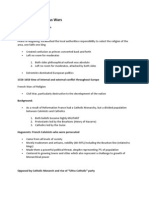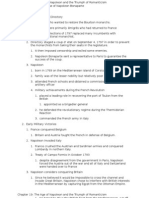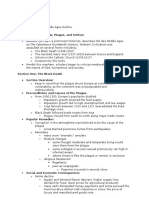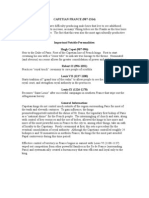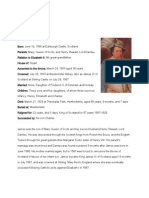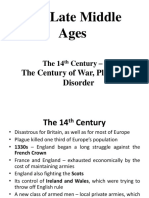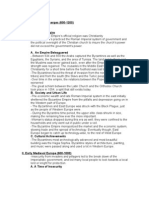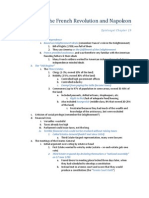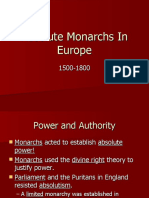Chapter 12 Study Guide
Chapter 12 Study Guide
Uploaded by
Brandon OglesbyCopyright:
Available Formats
Chapter 12 Study Guide
Chapter 12 Study Guide
Uploaded by
Brandon OglesbyCopyright
Available Formats
Share this document
Did you find this document useful?
Is this content inappropriate?
Copyright:
Available Formats
Chapter 12 Study Guide
Chapter 12 Study Guide
Uploaded by
Brandon OglesbyCopyright:
Available Formats
Chapter 12 Study Guide - The Age of Religious Wars Chapter Outline I. Renewed Religious Struggle II.
The French Wars of Religion (1526-1598) a. Appeal of Calvinism b. Catherine de Mdicis and the Guises i. The Peace of Saint-Germain-en-Laye ii. The Saint Bartholomews Day Massacre iii. Protestant Resistance Theory c. The Rise to Power of Henry of Navarre d. The Edict of Nantes III. Imperial Spain and the Reign of Philip II (r. 1556-1598) a. Pillars of Spanish Power i. New World Riches ii. Increased Population iii. Efficient Bureaucracy and Military iv. Supremacy in the Mediterranean b. The Revolt in the Netherlands i. Cardinal Granvelle ii. The Compromise iii. The Duke of Alba iv. Resistance and Unification v. The Pacification of Ghent vi. The Union of Arras and the Union of Utrecht vii. Netherlands Independence IV. England and Spain (1553-1603) a. Mary I (r. 1553-1558) b. Elizabeth I (r. 1558-1603) i. Catholic and Protestant Extremists ii. Deterioration of Relations with Spain iii. Mary, Queen of Scots iv. The Armada V. The Thirty Years War (1618-1648) a. Preconditions for War i. Fragmented Germany ii. Religious Division iii. Calvinism and the Palatinate iv. Maximilian of Bavaria and the Catholic League b. Four Periods of War i. The Bohemian Period ii. The Danish Period iii. The Swedish Period iv. The Swedish-French Period c. The Treaty of Westphalia
Commentary This chapter covers the religious wars in France, Spain's attempt to win an empire, Spanish relations with England and the Thirty Years' War. Non-Lutheran Protestants were not recognized by the Peace of Augsburg. Calvinism and Catholicism were irreconcilable church systems; Calvinism was committed to changing societies and was attractive to proponents of political decentralization while Catholicism remained congenial to those who favored absolute monarchy and "one king, one church, one law." After painful experiences, some rulers known as politiques subordinated theological doctrine to political-unity. With few interludes, the French monarchy remained a staunch Catholic foe of the French Protestants, who were called Huguenots, until 1589. Under the regency of Catherine de Medicis (for Francis II and Charles IX), three powerful families tried to control France: the Guises, the Bourbons and the Montmorency-Chatillons. The Guises remained devotedly Catholic while the Bourbons and the Montmorency-Chatillons developed Huguenot sympathies. Catherine tried to play them off against each other. She wanted a Catholic France, but
not under Guise domination. Three religious wars were fought between 1562 and 1570 and the Protestants were granted religious freedoms within their territories only to have the peace shattered by the St. Bartholomew's Day Massacre in 1572, which was supported by Catherine. Over 20,000 Huguenots were massacred on that day and Protestant reformers, who had urged strict obedience to the established political authority, now began to realize that they had to fight for their rights. Further political fighting finally resulted in the succession of the Protestant Henry of Navarre to the throne as Henry IV. Philip II of Spain was alarmed at the prospect of a Protestant France, but Henry was a politique and wisely converted to Catholicism while granting minority religious rights in an officially Catholic country (Edict of Nantes, 1598). Philip II (1556-1598) inherited the western Hapsburg kingdom, where new American wealth had greatly increased Spanish power. During the first half of his reign, he focused attention on the Turkish threat and in the battle of Lepanto (1571) the Turks were decisively beaten by the Holy League. In 1580, Spain annexed Portugal. But Spanish armies were not successful in the Netherlands, which were composed of Europe's wealthiest and most independent towns; many were also Calvinist strongholds, Initial resistance was brutally arrested by the Duke of Alba. But after 1573, the independence movement was headed by William of Orange. By 1577, a unified Netherlands forced the withdrawal of all Spanish troops. It was especially the resistance of the Netherlands that undid Spanish dreams of world empire. Although efforts to reconquer the Netherlands continued into the 1580s, Spain soon became preoccupied with England and France. In England, Mary I (1553-1558) reverted to the strict Catholic practice of her father, Henry VIII. Her successor, Elizabeth I (1558-1603), was a politique who merged a centralized episcopal system with broadly defined Protestant doctrine and traditional Catholic ritual. English relations with Spain soon deteriorated. In 1570, Elizabeth was excommunicated for heresy and throughout the decade English seamen preyed on Spanish shipping in the Americas. In 1585, Elizabeth committed English soldiers to fight against the Spanish in the Netherlands. Finally, she was compelled to execute her Catholic cousin Mary, Queen of Scots, in 1587. Philip launched his Armada against England in 1588, but was soundly defeated; Spain never really recovered from this defeat. In the second half of the sixteenth century, Germany (the Holy Roman Empire) was a land of about 300 autonomous political entities (secular and ecclesiastical principalities, free cities and castle regions). Religious conflict accentuated these divisions; during this time, the population was about equally divided between Catholics and Protestants. In 1609, Maximilian of Bavaria organized a Catholic League to counter a Protestant alliance recently formed under the leadership of the Elector Palatine, Frederick IV. The stage was set for the worst of the religious wars, the Thirty Years' War. The chapter then details the conflict, which is divided into four periods: the Bohemian (1618-1625), the Danish (1625-1629), the Swedish (1630-1635) and the Swedish-French (1635-1648). About one-third of the German population died in this war, which was ended by the Treaty of Westphalia in 1648. Among other provisions, it asserted the cuius regio, eius religio principle of the Peace of Augsburg and gave legal recognition to the Calvinists. This treaty perpetuated German division and political weakness into the modern period. Art & the West focuses on warring architectural styles: Baroque vs. Plain churches. Key Concepts Extension of the Political Conflict of the Reformation In the second half of the sixteenth century, the political conflict, which had previously been confined to central Europe and a struggle for Lutheran rights and freedoms was extended to France, the Netherlands, England and Scotland - and became a struggle for Calvinist recognition. German Lutherans and Catholics had agreed to live and let live in the Peace of Augsburg (1555) with the credo that he who controls the land may determine its religion. The Calvinists were excluded from this treaty and it was not until 1648 after the bloody Thirty Years' War and the Treaty of Westphalia, that they too received legal recognition. The Spanish Armada As a response to growing English power and disruption of Spanish shipping and land interests, Philip II of Spain launched the Armada of 130 ships against England. The swifter English vessels together with inclement weather inflicted defeat on Spain and the loss of over one-third of her vessels. The news of the Armada's
defeat gave heart to Protestant resistance. Although Spain continued to win impressive victories in the 1590s, it never fully recovered from the defeat. The Anglican Church One of the most skillful religious compromises attained during this period of religious war was the establishment of the Anglican Church. Elizabeth sought a compromise between Catholics and Protestants, which resulted in a church which was officially Protestant in doctrine and Catholic in ritual. Extremists on either side opposed the arrangement and there were conspiracies against Elizabeth. But the compromise proved lasting (with incidental changes) to the modern day. Elizabeth was a classic politique and it was due to her efforts that England did not succumb to the bloody warfare on the Continent. 1. How did Elizabeth I deal with the religious issue in England when she became queen? 2. Why did Elizabeth I put Mary Stuart under house arrest for so many years? What was she afraid of? 3. What role did Sir Francis Drake and the "Sea Dogs" play in the growing tensions between England and Spain? 4. Regarding Queen Elizabeth I's "Armada" speech: - How does she appeal to her subjects by describing herself as both a woman and a king? Why was it necessary for her to take this approach? - Who and what are the enemies of Elizabeth and England in this speech? - How does the speech draw on English nationalism without making it a religious issue? Why would she play down religious tensions? 5. Why did Philip II take upon himself the leadership of the Catholic Counter-Reformation? Why was Spain ideally suited to be the instrument of Philip's ambitions? 6. What was the general state of political and religious affairs in Europe in the first years of Philip II's reign? What conflict existed between religious and national loyalties? 7. Why did Philip II send the Spanish Armada against Elizabeth I in 1588? What were the results of this move for Spain? for England? 8. What were the political, economic, and religious issues that entered into the revolt of the Netherlands? How did this revolt merge with the international political and religious struggles in Europe at the time? 9. Why did Spain decline as a major European power during the reign of Philip III? What role did the Catholic Church especially play in this decline? 10. Analyze the validity of this statement: The Thirty Years' War was in part a German religious war and in part a German civil war fought over constitutional issues in the Holy Roman Empire. 11. How did European rivalries and ambitions become linked to the conflict within Germany in the late 16c and early 17c? 12. Create a CHART that briefly identify each stage of the Thirty Years' War --> What were the key issues? -- The results of each phase? -- The winners? -- The losers? 13. Identify the major provisions of the Treaty of Westphalia in the following areas by creating another CHART: the religious settlement, territorial changes, and political/diplomatic changes. 14. How did the Peace of Westphalia mark the advent in international law of the modern system of independent sovereign states? [notes] 15. Why have some historians labeled the Thirty Years' War the "last of the religious wars", while others have called it the "first modern war"? Which is the more accurate assessment? Why? 16. What was the military revolution which resulted from the Thirty Years' War? What effect did it have on warfare in the 16c and 17c? Key Words and Terms Define & Identify, using the text and/or a dictionary as necessary.
The House of Valois The Guises The Bourbons Huguenots
Habsburg Catherine de Medici St. Bartholomew Day Massacre
Henry (IV) of Navarre Edict of Nantes [1598] Paris is worth a mass
El Escorial William of Orange (the Silent) Compromise of 1564 (Netherlands) Spanish Fury Pacification of Ghent (1576) The Apology secular principalities Imperial Diet Mary Tudor Marian Exiles John Knox Elizabeth I politique Sir William Cecil Act of Supremacy (1559) regicide heart and soul of a king
Puritans Congregationalists Mary Stuart James VI (James I) Sir Francis Drake Philip II Battle of Lepanto Spanish Armada Philip III "Sea Beggars" Protestant Union The Palatinate Frederick V, Elector of Palatinate Catholic League Thirty Years' War [1618-1648] Max. I, Duke of Bavaria Ferdinand II
Bohemia Defenestration of Prague [General] Tilly Battle of White Mountain [1620] Albrecht von Wallenstein Edict of Restitution [1629] Gustavus Adolphus Cardinal Richelieu mercenaries Treaty of Westphalia [1648] United Provinces sovereign / sovereignty
Multiple-Choice 1._____ The defeat of the Spanish Armada in 1588 (a) confirmed England as Europe's dominant power. (b) saved France from Spanish conquest. (c) gave heart to Catholic supporters everywhere. (d) inflicted a defeat from which Spain never fully recovered. 2. _____ Albrecht of Wallenstein was a (a) devout Catholic spiritual leader. (b) brilliant and ruthless mercenary. (c) devout Catholic military leader. (d) none of the above. 3._____ Henry of Navarre (a) opposed the politiques. (b) rejected Catholicism for political reasons. (c) tolerated a Protestant minority in his country. (d) all of the above. 4._____ A major grievance of the Puritans was the (a) conducting of the mass in Latin. (b) abandonment of the Catholic ceremony and vestments. (c) continuation of the episcopal system of church governance. (d) both a and c. 5._____From Queen Elizabeth's point of view, the main problem caused by Mary Queen of Scots was that she was (a) more attractive than Elizabeth and could provide future heirs to the throne. (b) Elizabeth's legitimate successor who plotted to replace her. (c) Catholic and intended to eliminate the Church of England. (d) personally jealous of Elizabeth and sought to embarrass her at court. 6._____ The Spanish objective in the Netherlands was to (a) establish a major port at Antwerp. (b) make the country politically docile and religiously uniform. (c) maintain the status quo to disrupt English foreign policy. (d) end the Hanseatic League. 7._____ The phrase, cuius regio, eius religio, means (a) the king should always support the established religion. (b) the one who controls the land determines its religion. (c) whoever reigns may also serve as head of the religion. (d) whoever controls the religion may rule. 8._____ Philip II of Spain attempted to conquer (a) Portugal, France and Denmark. (b) Portugal, Italy and France. (c) Portugal, the Netherlands and England. (d) the Netherlands, Germany and England. 9._____ In the second half of the 16th century, Germany had about how many autonomous political entities? (a) 7 (b) 125 (c) 600 (d) 360
10._____ Both Henry III and Henry IV of France (a) maintained close political and religious ties with Spain. (b) were assassinated. (c) were victorious over Huguenot armies. (d) were Protestant leaders. True-False Rewrite false statements so that they are true. 1. _____ French Calvinism (Huguenotism) was supported by a minority of the population, but these included many nobles and bourgeois middle class people. 2. _____ An important cause of the Thirty Years' War was the awakening of German nationalism in the early seventeenth century. 3. _____ The marriage of Philip of Spain and Mary I of England was popular in both countries. 4. _____ The motto, "one king, one church, one law," was supported by Lutherans. 5. _____ The Spanish Fury referred to the destruction of the Aztecs. 6. _____ The Edict of Restitution (1629) intensified the conflict between Lutherans and Catholics in central Europe. 7. _____ Catherine de Medicis had to contend with the house of Burgundy for control of France after the death of Henry II. 8. _____ New military tactics employing greater mobility of infantry, cavalry, and artillery led to the military successes of Gustavus Adolphus during the Thirty Years' War. 9. _____ Both Henry III and Henry IV of France were assassinated as a result of bitter religious feelings in France. 10. _____ In the 1560s, the Duke of Alba brutally suppressed a Protestant uprising in the Netherlands. Completion 1. The outbreak of the ____________Years' War in 1618 made the international dimension of the religious conflict especially clear. 2. French Protestants are known as ____________, a term derived from Besancon Hugues, the leader of Geneva's political revolt against the House of Savoy in the 1520s. 3. On Saint ____________Day, August 24, 1572, Coligny and 3000 fellow Huguenots were butchered in Paris. 4. The Edict of ____________recognized and sanctioned minority religious rights within what was to remain an officially Catholic country. 5. Spanish mercenaries, leaderless and unpaid, ran amok in Antwerp on November 4, 1576, leaving 7000 people dead in the streets. The event came to be known as the Spanish ____________. 6. Queen ____________hoped to avoid both Catholic and Protestant extremism at the official level by pursuing a middle way. 7. Elizabeth dealt cautiously with the ____________, who were Protestants working within the national church to "purify" it of every vestige of "popery" and to make its Protestant doctrine more precise. 8. Drakes ____________ of the globe between 1577 and 1580 was one in a series of dramatic demonstrations of English ascendancy on the high seas. 9. As elsewhere in Europe, ____________ was the political and religious leaven within the Holy Roman Empire on the eve of the Thirty Years' War. 10. The Treaty of ____________ in 1648 brought all hostilities within the Holy Roman Empire to end. Essay/Discussion Questions:
1. How did Spain achieve a position of dominance in the 16th century? What were its strengths and weaknesses as a nation? What were Philip II's goals? Which ones were not successful and why? How might European history have been changed had the Spanish Armada been victorious? 2. Henry of Navarre (Henry IV of France), Elizabeth I and William of Orange were all politiques. Define the term in your own words and then explain why you agree or disagree with the statement. 3. "The Thirty Years' War is the outstanding example in European history of meaningless conflict." Explain why you agree or disagree with the statement. How could the war have been avoided? 4. Compare and contrast the religious compromises worked out in the Peace of Augsburg in Germany, the Edict of Nantes in France, and the Elizabethan religious settlement in Englan5. List in detail the terms of the Treaty of Westphalia. In your opinion, which of these terms appears to have had a lasting effect on the peoples of Europe? For Further Consideration of the Documents in Kagan Each of the following questions is designed to help you reach a better understanding of certain documents presented in the text. Feel free to refer to the document as necessary The value of a primary historical source should not be underestimated; it helps us to understand the nature of the era in which it was written. Theodore Beza Defends the Right to Resist Tyranny 1. How does Bezas viewpoint about the appropriate powers of the people and their rulers differ from ideas about leadership in the Middle Ages? 2. Beza was among the first to propose what would eventually be termed a social contract between governors and the governed. Explain the terms of the contract as Beza perceived it, and what he believed would happen if the terms were violated. Henry IV Recognizes Huguenot Religious Freedom 3. Was religious tolerance embodied in the Edict of Nantes? If so, explain how. If not, indicate what was missing. 4. Show how the Catholic and Reformed (Protestant) faiths were (or were not) equal under the Edict. An Unknown Contemporary Describes Queen Elizabeth 7. How does this description compare with that of Mary I? 8. How do the personal qualities and political skills of the two leaders differ?
You might also like
- Chapter 12 Age of Religious Wars NotesDocument7 pagesChapter 12 Age of Religious Wars NotesSteven TruongNo ratings yet
- CampbellDocument3 pagesCampbellAdel Harnane0% (1)
- Chapter 12 Age of Religious Wars NotesDocument3 pagesChapter 12 Age of Religious Wars NotesRabbityHeartNo ratings yet
- Article For GermanyDocument35 pagesArticle For Germanyapi-369525218No ratings yet
- The Monarchs of EuropeDocument39 pagesThe Monarchs of Europeapi-271959377No ratings yet
- Two Hundred Years in The Orange Citadel PDFDocument33 pagesTwo Hundred Years in The Orange Citadel PDFPeter MulhollandNo ratings yet
- Cheney PapersDocument12 pagesCheney PapersDavid L. Grinnell0% (1)
- Eighty Years War, 1567-1648: Europe, Ed. Clifford J. Rogers (Boulder: Westview Press, 1995), 1-6Document14 pagesEighty Years War, 1567-1648: Europe, Ed. Clifford J. Rogers (Boulder: Westview Press, 1995), 1-6RoxanaNo ratings yet
- Global Interactions in The Early Modern AgeDocument19 pagesGlobal Interactions in The Early Modern AgeAlessio NardinNo ratings yet
- Chapter 19 - Age of Napoleon and The Triumph of RomanticismDocument18 pagesChapter 19 - Age of Napoleon and The Triumph of RomanticismPaigegabriellex3No ratings yet
- Oracle Licensing Contracts Part2Document69 pagesOracle Licensing Contracts Part2Mette StephansenNo ratings yet
- Iceman Inheritance Prehistoric Sources of Western Mans Racism Sexism and Aggression YfsghifDocument2 pagesIceman Inheritance Prehistoric Sources of Western Mans Racism Sexism and Aggression YfsghifMaria MedinaNo ratings yet
- Maamor Vayita Eishel - Vayeiroh 5747Document32 pagesMaamor Vayita Eishel - Vayeiroh 5747leahNo ratings yet
- AP Euro Study Guide Chapter 12Document4 pagesAP Euro Study Guide Chapter 123l39h4ntNo ratings yet
- The Thirty Years WarDocument71 pagesThe Thirty Years WarCecil AsisNo ratings yet
- CHPT 1 OutlineDocument18 pagesCHPT 1 Outlineapi-324512227No ratings yet
- Ap Euro Chapter 12Document11 pagesAp Euro Chapter 12MelindaNo ratings yet
- Chapter 22 - The Age of Nation States-1Document10 pagesChapter 22 - The Age of Nation States-1gamermvp24No ratings yet
- Capetian FranceDocument2 pagesCapetian Francealekseyvashchenko100% (2)
- AP Euro Chapter 15Document8 pagesAP Euro Chapter 15Giulia ConleyNo ratings yet
- The Stuarts: The Stuarts, The Parliament and The Civil WarDocument15 pagesThe Stuarts: The Stuarts, The Parliament and The Civil WarIvana AgueroNo ratings yet
- King James IDocument23 pagesKing James IfritaNo ratings yet
- How Far Do You Agree That The Yorkists Remained A Serious Threat To Henry VIIDocument3 pagesHow Far Do You Agree That The Yorkists Remained A Serious Threat To Henry VIISam WyperNo ratings yet
- Argentine War of IndependenceDocument8 pagesArgentine War of Independencedzimmer6No ratings yet
- Absolutism Unit PowerpointDocument31 pagesAbsolutism Unit Powerpointskyy93No ratings yet
- Rebellion and Unrest 1547-1558Document4 pagesRebellion and Unrest 1547-1558TobyStanfordNo ratings yet
- EnglandDocument673 pagesEnglandMatijaMihokovićNo ratings yet
- Absolutism DetourDocument33 pagesAbsolutism Detourc. reyesNo ratings yet
- The Late Middle AgesDocument10 pagesThe Late Middle Agesgabi100% (1)
- Tirot Singh O1Document6 pagesTirot Singh O1jimfirstsohphoh29No ratings yet
- Chapter 9 OutlineDocument3 pagesChapter 9 OutlineFerrari92% (13)
- Sttephen of Blois's LetterDocument15 pagesSttephen of Blois's LetterJobanpreet Singh100% (1)
- French Revolution - Role of Lower ClassesDocument4 pagesFrench Revolution - Role of Lower Classessoadquake981100% (1)
- Storming of The BastilleDocument5 pagesStorming of The BastilleDhruv SHARMANo ratings yet
- Notes: The French Revolution and Napoleon: Spielvogel Chapter 19Document5 pagesNotes: The French Revolution and Napoleon: Spielvogel Chapter 19Klem NderituNo ratings yet
- Charles I As King 26.11Document22 pagesCharles I As King 26.11stuboo93No ratings yet
- Activities AncienregimeDocument4 pagesActivities AncienregimeMiquel VialNo ratings yet
- Sir Robert Filmer (1588–1653) and the patriotic monarch: Patriarchalism in seventeenth-century political thoughtFrom EverandSir Robert Filmer (1588–1653) and the patriotic monarch: Patriarchalism in seventeenth-century political thoughtNo ratings yet
- Chapter 18 The French RevolutionDocument15 pagesChapter 18 The French RevolutionDolores SantillanNo ratings yet
- The Economic Policies of Jean-Baptiste ColbertDocument8 pagesThe Economic Policies of Jean-Baptiste ColbertNaethe PoolNo ratings yet
- The Catholic Monarchs and The Spanish EmpireDocument8 pagesThe Catholic Monarchs and The Spanish EmpiremanavegaNo ratings yet
- 3 9outlineDocument2 pages3 9outlinealanamadzNo ratings yet
- Unit Outline Introduction The West Before 1300Document21 pagesUnit Outline Introduction The West Before 1300api-324512227No ratings yet
- Henry Frendo, The French in Malta...Document10 pagesHenry Frendo, The French in Malta...Ian MassaNo ratings yet
- Julio Claudian DynastyDocument20 pagesJulio Claudian DynastyJgormanbapstNo ratings yet
- Pirate Nation: Elizabeth I and Her Royal Sea RoversFrom EverandPirate Nation: Elizabeth I and Her Royal Sea RoversRating: 4 out of 5 stars4/5 (1)
- Hunt & Poole (Ed) Political History of England 07 Montague F C (1603 To 1660)Document525 pagesHunt & Poole (Ed) Political History of England 07 Montague F C (1603 To 1660)ANDRE DE WINNE100% (1)
- The Battle of WaterlooDocument14 pagesThe Battle of Waterlooana zetina100% (1)
- NAPOLEON BONAPARTE (1769 - 1821) : World History Notes-Rajesh NayakDocument6 pagesNAPOLEON BONAPARTE (1769 - 1821) : World History Notes-Rajesh NayakRohit SaxenaNo ratings yet
- Canute the Great, 995 (circa)-1035, and the Rise of Danish Imperialism during the Viking AgeFrom EverandCanute the Great, 995 (circa)-1035, and the Rise of Danish Imperialism during the Viking AgeNo ratings yet
- The Works 1Document190 pagesThe Works 1Gutenberg.org100% (2)
- The Houses of Lancaster and York (Barnes & Noble Digital Library): With the Conquest and Loss of FranceFrom EverandThe Houses of Lancaster and York (Barnes & Noble Digital Library): With the Conquest and Loss of FranceNo ratings yet
- How Did Venice Face Challenges Between The 15th and 18th CenturyDocument7 pagesHow Did Venice Face Challenges Between The 15th and 18th CenturyVernonNo ratings yet
- The Battle of Worringen 1288Document182 pagesThe Battle of Worringen 1288anaximandre06100% (1)
- Regensburg, Wandalgarius and The Novi Reform Revisited: Denarii: Charlemagne's MonetaryDocument16 pagesRegensburg, Wandalgarius and The Novi Reform Revisited: Denarii: Charlemagne's MonetaryMarius AndroneNo ratings yet
- Absolute Monarchs in EuropeDocument34 pagesAbsolute Monarchs in EuropeAzimul Aktar BarbhuiyaNo ratings yet
- England Is ADocument2 pagesEngland Is AȘova AngelicaNo ratings yet
- SP ch15 prt3Document7 pagesSP ch15 prt3irregularflowers100% (2)
- The Bloody CodeDocument25 pagesThe Bloody CodeDafydd Humphreys100% (20)
- Druga Gimnazija Sarajevo The Crusade Wars Renate Dujakovic: Word Count: 2073Document8 pagesDruga Gimnazija Sarajevo The Crusade Wars Renate Dujakovic: Word Count: 2073Edin Cehic CehaNo ratings yet
- Thuggish Covert Hand SignalsDocument17 pagesThuggish Covert Hand SignalsEmmanuel Isaiah SmithNo ratings yet
- Sahara India Pariwar Is An Indian Conglomerate Headquartered inDocument9 pagesSahara India Pariwar Is An Indian Conglomerate Headquartered inPrerna SinhaNo ratings yet
- Neurosky Eeg Brainwave Chip and Board Tgam1 PDFDocument10 pagesNeurosky Eeg Brainwave Chip and Board Tgam1 PDFNenad BlagojevicNo ratings yet
- Rolling Planning and Simulation For ReportingDocument2 pagesRolling Planning and Simulation For ReportingSelvakumar MurugesanNo ratings yet
- MCM - Aadhar - Name - Change - List 2020-21Document6 pagesMCM - Aadhar - Name - Change - List 2020-21Abdul khadarNo ratings yet
- Form 12BBDocument1 pageForm 12BBGopala KrishnanNo ratings yet
- Basic OT NotesDocument20 pagesBasic OT NotesNimshiNo ratings yet
- Request For Price Quotation: Pamantasan NG Lungsod NG MaynilaDocument4 pagesRequest For Price Quotation: Pamantasan NG Lungsod NG MaynilaEcosenseTechnologies GreenenergyNo ratings yet
- Financial Statements Point PresentationDocument34 pagesFinancial Statements Point PresentationRabie Haroun100% (1)
- Moorish National Republic Federal Government: Societas Republicae Ea Al MaurikanosDocument4 pagesMoorish National Republic Federal Government: Societas Republicae Ea Al Maurikanosakil kemnebi easley elNo ratings yet
- H2 Physics Summary Notes (GCE A-Level Syllabus 9749) (2017 Edition)Document39 pagesH2 Physics Summary Notes (GCE A-Level Syllabus 9749) (2017 Edition)karlzhu313No ratings yet
- Aii Dee 12982 23-11-2011 Dalvi Samina (Ashraf Qazi Ancl Mumbra) p2Document2 pagesAii Dee 12982 23-11-2011 Dalvi Samina (Ashraf Qazi Ancl Mumbra) p2zaheerbcNo ratings yet
- Financial AuditingDocument4 pagesFinancial AuditingĐoàn Thanh TâmNo ratings yet
- 2017 SCJ 114 - RAMPARSAD N V THE CHIEF EXECUTIVE OF THE DISTRICT COUNCIL OF FLACQ and ORS - Inordinate Delay To Bring Judicial Review ProceedingsDocument5 pages2017 SCJ 114 - RAMPARSAD N V THE CHIEF EXECUTIVE OF THE DISTRICT COUNCIL OF FLACQ and ORS - Inordinate Delay To Bring Judicial Review ProceedingsAzhar TautayaNo ratings yet
- The Immaculate Deception - The Bush Crime Family Exposed (1999) - Russell S. BowenDocument45 pagesThe Immaculate Deception - The Bush Crime Family Exposed (1999) - Russell S. BowentheaN0n1No ratings yet
- ThePirateBay Proxy ListDocument1 pageThePirateBay Proxy ListsmithsunknownNo ratings yet
- Resume - Hiba LarrachDocument1 pageResume - Hiba Larrachhi-bNo ratings yet
- Bill of LadingDocument10 pagesBill of LadingKavita Verma100% (1)
- Features of Administrative LawDocument33 pagesFeatures of Administrative LawAmita SinwarNo ratings yet
- Roman InquisitionDocument4 pagesRoman Inquisitionwinofvin9No ratings yet
- RF09 - Unenrollment of LearnerDocument1 pageRF09 - Unenrollment of LearnerAtina Lavadia100% (2)
- HA System Software Installation Guide (Solaris) - (V100R002C01 - 06)Document289 pagesHA System Software Installation Guide (Solaris) - (V100R002C01 - 06)Adrian FlorensaNo ratings yet
- Fearon, James D., and David D. Laitin. 2004. "Neotrusteeship and The Problem of Weak States." International Security 28 (4) - 5-43Document39 pagesFearon, James D., and David D. Laitin. 2004. "Neotrusteeship and The Problem of Weak States." International Security 28 (4) - 5-43Rommel Roy RomanillosNo ratings yet
- Health10 LM U2 PDFDocument30 pagesHealth10 LM U2 PDFMargerie Fruelda0% (1)
- Case Digests 4thDocument11 pagesCase Digests 4thredstar0325No ratings yet
- Constitutional Right To Speedy TrialDocument11 pagesConstitutional Right To Speedy TrialAkram KhanNo ratings yet
- JENSEN AND MECKLING A Summary PDFDocument6 pagesJENSEN AND MECKLING A Summary PDFponchoNo ratings yet
